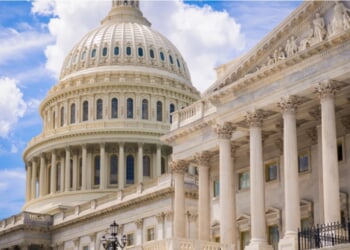As I write this, I have no idea what the final structure of President Trump’s tariff policy will be. So far, it has been on-again, off-again. But some of the rhetoric of Mr. Trump and members of his administration has been misleading rather than enlightening, confusing rather than clear. Let’s take a closer look at some of the rhetorical errors and excesses and try to understand the economic realities of trade. (RELATED: Tariff Delay Opportunities and Risks)
Team Trump talks in terms of “trade surpluses” and “trade deficits.” A so-called “surplus” occurs when people living in Country A export more to Country B than people living in Country A import from Country B. A “deficit” is the opposite: exports from A to B are less than imports from B to A. Incidentally, Team Trump has removed trade in services from the export/import tabulation. Since America has a trillion-dollar “surplus” in services alongside its “deficit” in goods, the omission of these transactions from the overall tabulation of trade inflates the overall trade “deficit.”
In the previous paragraph, I put quotation marks around “surplus” and “deficit” because, like many economists, I find those two terms misleading. Along with Trump’s dubious tendency to talk in terms of us “winning” at trade, these concepts are relics from the Age of Mercantilism (roughly from the time of Columbus to the birth of the USA). The grim mercantilist view of the world was that trade was a zero-sum proposition — that if one side to an exchange gained, then the other party must have lost. That is a fallacy. In everyday life, where economic exchanges (trades) are made voluntarily, both sides gain, or else one or the other party would have declined to make the trade. The trades are positive-sum, not zero-sum.
Question: When both sides gain from a trade, there is no deficit, because both sides gain; mathematically, the deficit is zero. Now multiply that single mutually beneficial voluntary exchange by millions of such exchanges. I wasn’t a math major, but I believe that zero times millions still equals zero. A “trade deficit” is an accounting artifact. In an economic sense, there is no deficit or surplus, no winner or loser, as is believed to be the case in mercantilist mythology and the Trumpian worldview. (RELATED: The ‘Most Bad’ Option: Trump’s Tariff Uncertainties)
Peaceful voluntary trade is not an adversarial act; rather, it is an act of reciprocal benefit. And yet, the president seems to view trade as not only adversarial but hostile. What is “hostile” about someone in one country producing something for the benefit or enjoyment of a person in another country? And yet Trump has gone so far as to charge that countries that have exported more to us than we have to them have “looted, pillaged, raped, and plundered” us. Question: Does that mean that we have “looted, pillaged, raped, and plundered” the countries to whom we have exported more goods than we imported from them? If so, then shouldn’t Trump be apologizing to Australia, Singapore, the United Kingdom, Brazil, and the Netherlands for the trade surpluses we have with them?
Trump speaks of it being a “privilege” for foreigners to access our markets. Why is it not also our privilege that foreigners produce things that we want and need?
Team Trump blames trade deficits on nefarious, deliberate actions by foreign powers. That is partly accurate. Foreign tariffs and other non-tariff trade barriers do indeed reduce the amount of American goods being exported to particular countries. By those means, foreign governments limit their citizens’ access to desirable goods, thereby reducing (sometimes marginally, sometimes significantly) the standard of living of their own people.
But there are several important counterpoints here: First, it is perfectly natural for Americans in aggregate to import more than we export for the simple reason that we are wealthier. We can afford a higher standard of living by consuming more goods than people from less-wealthy countries can afford. Second, it doesn’t make sense to retaliate against foreign tariffs that work against the economic welfare of its own people by making certain desired goods less available and/or more expensive to Americans. The logic is nonsensical: ”You are hurting your people, so we’re going to get back at you by hurting our people. Take that!”
Third, when we import more than we export, we collectively improve our standards of living more than our trading partners do. In another throwback to disproven mercantilist dogma, Trump apparently believes that the country that exports more goods and, in return, amasses more money is the wealthier country. Adam Smith exposed that money fallacy, explaining that it is the population that has access to and consumes more goods that is, in fact, wealthier than the country that consumes less. It is a bit spooky to think that Mr. Trump prefers mercantilist myths to the time-tested economic wisdom of Adam Smith.
In global free trade, humanity wins to the extent that peaceful relations develop and the division of labor becomes more inclusive, hence more productive. However, let us be cautious about accepting as dogma the notion that trade is never fraught with dangers. When a hostile power like China seeks to assert hegemonic control over specific industries crucial to national defense, bold and even economically painful measures may be called for. That is where we are today.
In an ideal world devoid of war and aggression, free trade makes sense. But today’s world is far from ideal. I don’t have a ready suggestion for how to most effectively take on the Chinese Communist Party, but I acknowledge that economic warfare seems unavoidable. My sense is that we should strive to maintain close ties with other countries for our side to have the best chance of winning (and in war, unlike voluntary trade, there are winners and losers — or at least, one side tends to lose less than the other). I wish President Trump every success as he confronts and challenges the Chinese threat.
READ MORE from Mark W. Hendrickson:
Confusion About Tariffs in the Trump Administration




![Jasmine Crockett Justifies Mass Illegal Immigration With Bizarre Argument [WATCH]](https://www.right2024.com/wp-content/uploads/2025/03/1742007023_Jasmine-Crockett-Justifies-Mass-Illegal-Immigration-With-Bizarre-Argument-WATCH-350x250.jpg)
![Red Sox Fan Makes the ‘Catch of the Day’ with Unconventional ‘Glove’ [WATCH]](https://www.right2024.com/wp-content/uploads/2025/04/Red-Sox-Fan-Makes-the-‘Catch-of-the-Day-with-350x250.jpg)

![NYC Tourist Helicopter Falls into Hudson River, Siemens Executive and Family Among Those Killed [WATCH]](https://www.right2024.com/wp-content/uploads/2025/04/NYC-Tourist-Helicopter-Falls-into-Hudson-River-Siemens-Executive-and-350x250.jpg)








